
About UsThe Numismatic Bibliomania Society is a non-profit organization promoting numismatic literature. For more information please see our web site at coinbooks.org SubscriptionsThose wishing to become new E-Sylum subscribers (or wishing to Unsubscribe) can go to the following web page link MembershipThere is a membership application available on the web site Membership Application To join, print the application and return it with your check to the address printed on the application. Membership is only $15 to addresses in the U.S., $20 for First Class mail, and $25 elsewhere. For those without web access, write to: David M. Sundman, Secretary/TreasurerNumismatic Bibliomania
Society AsylumFor Asylum mailing address changes and other membership questions, contact David at this email address: dsundman@LittletonCoin.com SubmissionsTo submit items for publication in The E-Sylum, just Reply to this message, or write to the Editor at this address: whomren@coinlibrary.com
BUY THE BOOK BEFORE THE COINYou won't regret it! |
- WAYNE'S WORDS: THE E-SYLUM OCTOBER 21, 2012
- NEW PERIODICAL: JOURNAL OF NUMISMATIC RESEARCH
- NEW BOOK: COINS OF THE BENGAL PRESIDENCY
- NEW BOOK: AFRICAN CURRENCY
- NEW BOOK: HETTY GREEN IN THE GILDED AGE
- BOOK REVIEW: HISTORY OF COLLECTING CONFEDERATE STATES PAPER MONEY
- THE COPYRIGHT SYMBOL ON COINS
- VOCABULARY WORD: QUASQUIBIDUODECENTENNIAL
- MORE ON DELAWARE'S MONEY BEACH COINS
- NOTES FROM E-SYLUM READERS: OCTOBER 21, 2012
- ON THE ORIGIN OF THE CONTINENTAL DOLLAR
- NEW RESEARCH ON THE VOTE THE LAND FREE COUNTERSTAMP
- QUERY: MINT DELIVERY WARRANTS AND TREASURER RECEIPTS SOUGHT
- QUERY: HOW BEST TO CATEGORIZE HORSE MEDALS?
- ARTICLE ON PRESSED DISK MADE FROM PLACER GOLD SOUGHT
- MEDAL LISTS, LIST MEDALS AND MEDAL PRICES
- SHOULD THE U.S COMMEMORATIVE COIN PROGRAM BE SHUT DOWN?
- 1962 SEATTLE WORLD'S FAIR DOLLAR DISPLAY BROCHURE
- HARVEY STACK : HOW NEW YORK BECAME THE “COIN CAPITAL OF THE WORLD”
- COIN COLLECTING AND DEALING IN DALLAS, TEXAS
- NEWS PUBLICATIONS CONTINUE SHIFT FROM PRINT TO ONLINE
- OBSOLETE BANKNOTE EXHIBIT: CAPITAL OF CAPITAL: NEW YORK’S BANKS
- ROMAN GOLD COIN HOARD FOUND IN HERTFORDSHIRE
- QATARI SHEIK LATE IN PAYING FOR COIN PURCHASES
- BONHAMS SELLS RARE QATAR AND DUBAI BANKNOTES
- IRAN SANCTIONS MAY CUT BANKNOTE SUPPLIES
- FIVE HILARIOUSLY BAD YOUTUBE COIN VIDEOS
- JED CLAMPETT'S TRAVELLING NUMISMATIC BOOKMOBILE
- FEATURED WEB SITE: FLEUR DE COIN
WAYNE'S WORDS: THE E-SYLUM OCTOBER 21, 2012

New subscribers this week include Adolfo Bartolomucci, Justin Stultz, Phil Kolocotronis, John Tornatore and Mark Jankowski. Welcome aboard! We have 1,601 email subscribers, plus 194 followers on Facebook.
This week we open with the debut of the Journal of Numismatic Research and three new books. Other topics include the origins of the Continental Dollar coinage, new research on the Vote The Land Free counterstamp, Mint Delivery Warrants and Treasurer's receipts, and the fate of the modern U.S. commemorative coin program.
To learn more about Horse Medals, How to Bake Proof Coins, the display of silver dollars at the 1962 Seattle World's Fair, a thimble-full of plate, a mite of gold and Five Hilariously Bad YouTube Coin Videos, read on. Have a great week, everyone!
Wayne Homren
Editor, The E-Sylum
NEW PERIODICAL: JOURNAL OF NUMISMATIC RESEARCH
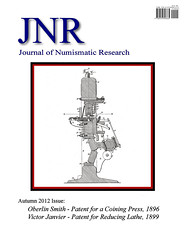 PAGE 7 -
PAGE 7 -
OBERLIN SMITH – PATENT FOR A COINING PRESS, 1896
United States patent number 574227 was issued to Oberlin Smith on December 29, 1896. Smith was owner of the Ferracute Company and had many years of experience in designing and manufacturing industrial and machine shop presses, lathes and other equipment. His company produced only two sizes of coin presses and sold a few to the U.S. Mint and others to foreign governments. This is the first publication of Smith’s complete patent text and illustrations.
PAGE 23 -
VICTOR JANVIER – PATENT FOR A MODEL REDUCING MACHINE, 1899
French and English - New translation by Margaux C. Thieme-Burdette
Among American numismatists Victor Janvier is known almost entirely for the model reducing machine of his invention that was installed in the Philadelphia Mint in 1906. The first test was in December when Barber and Morgan made hubs for a sample double eagle. In January 1907 the first reductions of Saint-Gaudens' double eagle models were made. The French patent, number 294123, was issued on November 8, 1899 and amended in February 24, 1902. This is the first publication of his patent and includes all documents remaining in the French patent office archive.
The PDF version of Journal of Numismatic Research (JNR) is available exclusively from Wizard Coin Supply’s web site. This issue has a cover price of $10 in electronic or printed versions. Wizard will also be the exclusive distributor of all printed and electronic editions of JNR, and of Roger's forthcoming book, United States Pattern and Experimental Pieces of WW-II.
Roger is the author of “Renaissance of American Coinage” (Numismatic Literary Guild Book-of-the-Year three years in a row) series and “Guide Book of Peace Dollars,” Assay Commission Records – 1800-1943” and Silver Dollars Struck under the Pittman Act.”. He is a Federal Court-approved numismatic expert, contributor to the Red Book, Judd Patterns and many other fine numismatic books, discoverer of two gold patterns, and author of numerous coin research articles.
To order a copy, see: www.wizardcoinsupply.com/journal-of-numismatic-research/
NEW BOOK: COINS OF THE BENGAL PRESIDENCY
Caroline adds:
It is the first of three volumes written by Dr. Paul Stevens that document the coins of the East India Company. The first volume explores the coins and mints of the Bengal Presidency from 1757, when the EIC first acquired the right to mint coins there, until 1835, when a uniform coinage was introduced into British India. The three volumes will, without doubt, become the new industry reference works.
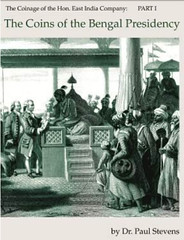 THE COINAGE OF THE HON. EAST INDIA COMPANY – PART 1
THE COINS OF THE BENGAL PRESIDENCY
THE COINAGE OF THE HON. EAST INDIA COMPANY – PART 1
THE COINS OF THE BENGAL PRESIDENCY
Dr. Paul Stevens first book, ‘The Coins of the Bengal Presidency’ is an essential reference work for anyone interested in this period of Indian history, British colonial history and East India Company coinage. The first of a planned three part series on the coins of the East India Company, this will be the new standard reference work for the next generation of numismatists.
Written by the highly respected numismatist Dr. Paul Stevens who became interested in Indian coinage during the 1970’s and was particularly fascinated by the coins which were produced by the British for use in India, the book is a result of many hours spent poring over primary source documents in the British Library. It explores the coins and mints of the Bengal Presidency from 1757, when the EIC first acquired the right to mint coins there, until 1835, when a uniform coinage was introduced into British India.
Divided into ten chapters, each one deals with a different time or location of the coinage. Each chapter then consists of a short summary followed by a very detailed exploration of the information found mainly in the archives of the EIC. This part contains extensive archival extracts, which should prove useful to both numismatists and historians studying the EIC. Next, (within each chapter,) there is a detailed catalogue of the coins discussed within that chapter, and finally there is a list of references that will ensure that the original sources can easily be found.
At the end of the book there are some useful appendices: an AH/AD/RY concordance; a glossary of Indian words and abbreviations found in the extracts from the records; a concordance of Pridmore numbers with the Stevens catalogue numbers; and the mint names and rulers’ names as they actually appear on the coins. Many other fascinating pieces of information could also be mentioned but they are all in the book and that is where they should be sought.
 Baldwin’s is delighted to be offering 142 lots of British Indian coins from the collection once formed by Dr. Stevens in their 3rd November Argentum auction. Lots 230 – 372 from the catalogue contain a variety of beautiful coins from the Madras, Bombay and Bengal presidencies, including lot 340 (pictured here) a 1794, Gilt Proof 2-Pice.
Baldwin’s is delighted to be offering 142 lots of British Indian coins from the collection once formed by Dr. Stevens in their 3rd November Argentum auction. Lots 230 – 372 from the catalogue contain a variety of beautiful coins from the Madras, Bombay and Bengal presidencies, including lot 340 (pictured here) a 1794, Gilt Proof 2-Pice.
The Coins of the Bengal Presidency, published by Baldwin’s, is priced at £50 plus postage and can be ordered through the Baldwin’s website at www.baldwin.co.uk . The catalogue for the Baldwin’s Autumn Argentum auction with full listing of all 142 coins can be found online at www.baldwin.co.uk/a312
NEW BOOK: AFRICAN CURRENCY
 AFRICAN CURRENCY
AFRICAN CURRENCY
Monete tribali dell’Africa subsahariana
Author: Adolfo Bartolomucci
Test:
Aldo Tagliaferri
Piero Voltolina e Mary Beni
Giorgio Teruzzi
Lidia Calderoli
Language: Italian and English
Copyright 2012 by African Art Gallery – Milan
23x30,5 cm, 189 pages
320 color photographs
7 black and white photographs
Hardbound cover
Price: € 40
There is a wide-spread revival of interest in artifacts that served for many centuries as legal tender in Sub-Saharan Africa, and this richly illustrated catalogue, edited by Adolfo Bartolomucci, purports to present and investigate the extraordinary range of objects concerned. Contributions by scholars of African lore situate these expressions of native ingenuity in an historical context and document their connection to everyday living conditions and the beliefs prevailing among the different ethnic groups that produced them. The many questions raised by the monetary use of artifacts of this type were of necessity examined from different angles.
The more widely known examples of African currencies date back to early West African cultures, but lesser-known types, such as those introduced by European colonial powers or found in areas far off the beaten tracks of commerce, deserve no less attention.
In his introduction the editor communicates his experiences over decades of field-trips through Africa.
The essays that follow address various aspects of the problem: Lidia Calderoli illustrates how much these objects owe to the skill and versatility of African smiths, Aldo Tagliaferri comments on the relationship between function and inherent meaning, while others provide further background and explain the use of specific items, such as conch shells and glass beads, known to have played an important role in the economic systems of Africa.
All the currency presented in this book – 227 kinds, 361 pieces – is part of a collection belonging to the African Art Gallery of Milan. The collection may be viewed on site in Milan at 28 Via Caterina da Forli. All the objects are mounted on iron. The entire collection (361 pieces) can be bought along with 300 copies of the book African Currency by collectors, foundations, museums, banks or galleries.
The making of this book, the result of more than 50 years of research and study in South-Saharan Africa, required courage, great efforts and, above all, perseverance in dedicating the major part of time spent in Africa on a subject held to be unimportant by most. I took a trip through the Nok area where I was shown a forged iron, shovel-shaped object and told that it was a currency used in commercial transactions in the 1920’s and ’30’s. I promptly bought it. That was the beginning of my interest in these strange metal objects, which we called ethnic currency.
Sometime later, going through the frontier zone between the Ivory Coast and Liberia, I found a big bronze ankle bracelet with bells that weighed 4 kg. It belonged to a woman and the fact that she was the wife of the village chief conferred particular importance to this currency. Bought after lengthy negotiations, this ankle bracelet also became part of my currency collection, and from that moment on I began to systemically look for these currencies in every country or area that I visited.
Consulting old books written by European explorers, I realized that all the nations and all the nations and all the ethnic groups in various shapes and sizes which were used for commercial exchanges in place of minted money. Their value depended principally on shape and weight. Over time I discovered that there was glass bead currency and that artefacts of ivory, shells, pieces of fabric and other objects could also be employed as currency. I collected most of the currencies proposed in this book on site from families or from local vendors who sold these materials; however they had scarce information about how or when they were made and how they were used.
I saw my first real Luba exemplar, an X shape in copper, during the first trip I took in Katanga: I was already aware of the shapes because in 1961 the provisory Katanga government had minted two official coins on which the old X-shaped currency was reproduced. The most surprising impact I had in regard to this currency was with the Guinzé, called Kissi penny by the Europeans and used among the Kissi and the Loma of Liberia and the Conakri in Guinea. During a trip from the Ivory Coast to Malì I decided to take the Abidjan - Man - Zérékoré – Sigiri – Bamako route. I actually saw my first real Kissi pennies in Zérékoré, a territory of Guinea.
From 1995-2000 there was a turning point in the currency market. The interest of European traders was so strong that the market squares in Lomè, Abidjan, Duala and Acra were over flowing with every sort of object defined as currency. When I was in Lomé I saw embossed, forged iron sheets weighing from 8-15 kg. that were hoe shaped-shaped. They came from Nigeria, and I was told that these Angas currencies were used as a gift for the father of the bridge during the wedding and also for buying animals, slaves and weapons. In the Abidjan market on the Ivory Coast, I found notable quantities of Liganda, forged iron objects similar to long lances, Mbole copper ankle bracelets and bronze Ekonda leg shields, all coming from Congo Leopoldville, as the D.R.C. was called at the time.
For more information, see: www.africanartgallery.it
NEW BOOK: HETTY GREEN IN THE GILDED AGE
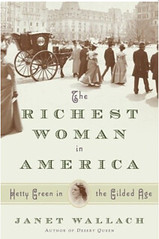 “I enjoy being in the thick of things. I like to have a part in the great movements of the world and especially of this country. I like to deal with big things and with big men.”
“I enjoy being in the thick of things. I like to have a part in the great movements of the world and especially of this country. I like to deal with big things and with big men.”
So said Hetty Green, who was known as the Queen of Wall Street and, less flatteringly, as the Witch of Wall Street, according to a new biography by Janet Wallach. Green, who was born in a well-to-do Quaker family in 1834, made her fortune during the Gilded Age by investing in railroads and lending money to America’s great cities, including New York and Chicago. When she died in 1916, she was worth at least $100 million, the equivalent of about $2.5 billion today, making her the world’s richest woman in her day.
Green was feared and loathed — as Wallach makes clear, the rules have always been different for women than for men, and a woman who made rather than spent wasn’t to be trusted.
Although Green famously didn’t spend money on a doctor for her young son when he injured his knee, and his leg later had to be amputated, Wallach also relates how Green once pulled out a gun to a businessman who made threats against the boy. “Harm one hair of Ned’s hair and I’ll put a bullet through your heart,” she said. And Wallach tells how, when a deliveryman fell from his cart in Paris, Green rushed to the wounded man’s side and cleaned him up with her handkerchief. The marchioness who employed the footman, having no clue who Green was, offered her a job as a superintendent in a hospital. Green was not offended. Instead, she thanked the marchioness for the compliment of a job offer.
Wallach’s book is also about how Green made her money, and aspiring investors might want to memorize her words as they do Warren Buffett’s. Green’s father, Edward Robinson, “made it a practice never to borrow,” and Green too was always a lender. “I buy when things are low and nobody wants them,” she said. “I keep them until they go up and people are crazy to get them. That is, I believe, the secret of all successful business.”
To read the complete article, see:
“The Richest Woman in America” Hetty Green in the Gilded Age” by Janet Wallach
(www.washingtonpost.com/opinions/the-richest-woman-in-america-hetty-green
-in-the-gilded-age-by-janet-wallach/2012/10/20/7cb3a8b8-fc20-11e1-8adc-499661afe377_story.html)
BOOK REVIEW: HISTORY OF COLLECTING CONFEDERATE STATES PAPER MONEY
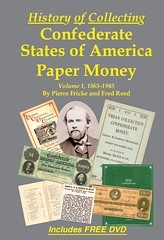 I've been reading Pierre Fricke and Fred Reed's book, History of Collecting - Confederate States of America Paper Money Volume 1, 1865 to 1945.
It's a delightful volume, and I'd recommend it to any student of U.S. numismatic history with or without a particular interest in Confederate States of America paper money. There is much to learned about our hobby and the great collectors who preceded us.
I've been reading Pierre Fricke and Fred Reed's book, History of Collecting - Confederate States of America Paper Money Volume 1, 1865 to 1945.
It's a delightful volume, and I'd recommend it to any student of U.S. numismatic history with or without a particular interest in Confederate States of America paper money. There is much to learned about our hobby and the great collectors who preceded us.
This book continues a great tradition begun by Q. David Bowers in his 1964 book, Coins and Collectors. Dave introduced readers to a world of numismatic history - the great coin collectors and the great coin collections they formed. It was a coin book that wasn't a pure reference book; it was something to be enjoyed cover to cover. There oughta be a book like this for every major collectible series. Roger Siboni's chapter on Collectors and Their Collections, an excerpt from an upcoming book on New Jersey coinage published in The Asylum is another great example. Perhaps no single publisher could or would produce a series on all important areas collecting, but these are great starts and I know I'll look forward to future volumes in this "History of Collecting" series.
I won't march thru the book chapter by chapter, as that has been covered in earlier E-Sylum articles. What follows are some random thoughts as a reader.
One of the first things I noted were some vocabulary words I was unfamiliar with, like "plen". A short glossary would have been useful. I asked Pierre and he defines it as:
Plate letter-number. Like A 26 on a T-18.
In addition to some vocabulary words, I learned a lot of interesting things from the book. One was the importance of research by H.D. Allen, published in The Numismatist in 1917 through 1919. His work unfortunately was never published in book form, making it less accessible to collectors. But his contributions were monumental, overturning a number of incorrect assumptions and attributions made by earlier writers.
Another thing I learned was that many of the top collectors of the day had holdings of Confederate notes, even though it was not their main focus. For example. Dr. Maris of Large Cent and New Jersey coinage fame had some 40 lots of Confederate items when his collection was sold.
As bibliophiles know, one can learn a lot by reading through old auction catalogs. On p201 the authors illustrate a page from the Chapman wale of the William Gable collection. Before a group of lots of Confederate notes S.H. Chapman writes:
Complete set of each denomination is given in Thian's album but his arrangement by denomination is so bad I will not follow it and will catalog then chronologically....
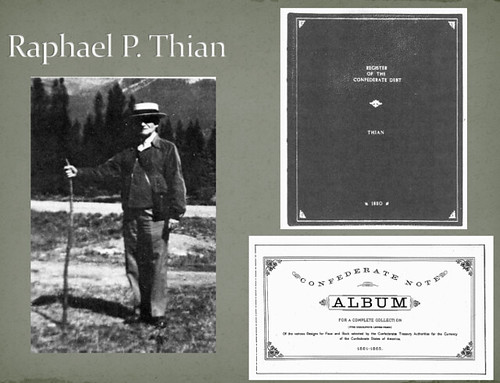
Chapter 8, "Government Seizures of 1919" was all news to me. I was completely unaware of this episode, which could have put the kibosh on collecting and selling Confederate paper money for decades. In short, a number of hucksters had begun buying up old Confederate notes and turned around and passed them to ignorant shopkeepers out west who didn't realize they were worthless. Coin dealers, who advertised nationally and sold bulk lots were being targeted as middlemen in a counterfeiting scheme.
Ultimately the issue was resolved with the Federal government, but not without a lot of consternation in the hobby and the destruction of some $60 million in Confederate notes by the government. The swindling was curbed in the U.S. but then moved overseas.
I have no one but myself to blame for not knowing much about this episode or the Allen work. I have a full set of The Numismatist sitting on my shelves, but have never read all the way through them. That's something Dave Bowers had the initiative to do early in his career, and I would recommend it to any aspiring young numismatist. Luckily we have authors like Fricke and Reed who have done the legwork for us.
I should have mentioned right up front that this book is a treasure for bibliophiles. Color illustrations throughout picture a multitude of numismatic items from books to auction catalogs to ephemera such as dealer price lists and buying guides. I found myself thinking like a baseball card collector - got it, got it, need it, got it, didn’t know that EXISTED! I used to think I had a pretty good collection of Confederate numismatic literature, but now I know I have a lot of holes. The accompanying DVD is a great companion item. The illustrations in this review were taken from a slide presentation on the DVD. It doesn't include all the text of the book, but it does have some good companion material.
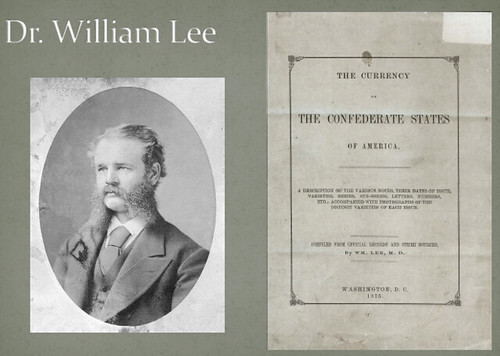
My primary compliant about the book is no fault of the authors' - the pages were all stuck together at the bottom, perhaps a cutting error by the printer or some stray glue. I also found it sometimes confusing that the authors duplicated in the main text words found in many of the illustrations. I understand why they did that and I would probably do the same - some of the images can be hard to read. But I often found myself asking - "hey - didn’t I just read that? Am I losing my marbles here?"
I'll stop there, but want to again heartily recommend the book. A great job, and a great example to future authors. I'd love to see more "History of Collecting" type books.
To read an earlier E-Sylum articles, see:
NEW BOOK: HISTORY OF COLLECTING CONFEDERATE STATES PAPER MONEY
(www.coinbooks.org/esylum_v15n18a03.html)
and
BOOK REVIEW: HISTORY OF COLLECTING CONFEDERATE STATES PAPER MONEY
(www.coinbooks.org/esylum_v15n30a04.html)
THE COPYRIGHT SYMBOL ON COINS
Regarding the New Zealand Hobbit coin, last week I asked, "Is this the first coin to include the copyright symbol?"
Martin Purdy writes:
The 2005 King Kong "coins" (I'm still trying to find a suitable, succinct expression for "Art Medal Bearing a Denomination of Convenience") carried the legend "© UNIVERSAL STUDIOS" on the reverse, so the new issues aren't the first. Not sure about the previous swag of Lord of the Rings AMBDCs in 2003 - I can't really bear to deal with any of them up close!
To read the earlier E-Sylum article, see: COPYRIGHT AND THE NEW ZEALAND HOBBIT COINS (www.coinbooks.org/esylum_v15n43a27.html)
VOCABULARY WORD: QUASQUIBIDUODECENTENNIAL
You have no idea how much older it makes me feel to have a young pup like you refer to yourself as an old geezer. Where does that leave me? Just because I collect Sesquicentennial medals (yes, I obey Abler’s Fourth Law of Collecting, and I do collect more than one thing) and therefore know the meaning of Sesquicentennial does not make me, let alone you, an old geezer!
Doesn’t everyone commemorate quasquibiduodecentennial anniversaries?
Quasquicentennial = 125th year
duodecennial = 12th anniversary
bi = 2
125 + (2*12) = 149
Ron and I continued the thread in subsequent emails (see below). -Editor
Ron: "I’d like to go back with a complete list of winning lottery numbers (then I’d start going to coin auctions)! Can you spell Croesus?"
Me: "State lotteries weren't quite invented yet, either. Betting on horse races and ballgames would work, but win too many times and the mob'll put you in cement overshoes before you could buy too many coins..."
Ron: "Spoil sport! Okay, one result sheet from a prior day at the track will work well enough. One big win would finance one big coin auction, assuming that the time machine lets me bring back a briefcase full of coins."
That last one's a joke that will stop being funny someday. We already have cow-milking robots and accident-free driverless cars. One of these days people may well be able to take naps safely in the car, even as the kids ask, "What's a driver's seat?". -Editor
To read the earlier E-Sylum article, see: NEW BOOK: ABRAHAM LINCOLN: BEYOND THE AMERICAN ICON (www.coinbooks.org/esylum_v15n43a05.html)
MORE ON DELAWARE'S MONEY BEACH COINS
Ron Ward writes:
There are a number of references to the "Faithful Steward" wreck off the coast of Delaware in the Internet. One mentions that 400 barrels of copper coins were on board to be used as currency in the American Colonies. In 1999 I purchased a "Shipwreck Coin" from a dealer in Magnolia, DE who said it was washed ashore on a beach. I identified it as a George III, Irish Hibernia halfpenny with a 1782 date.
1) www.discoversea.com/Delaware's-Coin-Beach.html
2) Coin World article Nov. 8, 2011
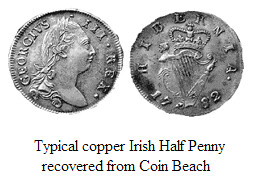
www.discoversea.com/Delaware's-Coin-Beach.html
Byron Weston writes:
I believe I can offer Dick Doty some clarity about the 1784 contemporary counterfeit halfpenny that was found on Coin Beach with the attached article from CNL
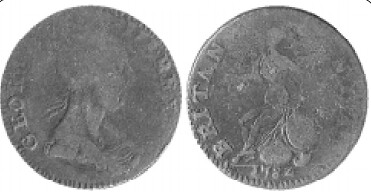
Figure 12: "Coin Beach" 3826/14-84A.
One ground found example of 3826/14-84A, although not found using a metal detector, does perhaps offer a clue as to its origin because of where it was found.28 This example was found sometime in the 1930s or 1940s according to an online Yahoo egroup member by his grandfather on what is known as “Coin Beach,” near Rehoboth Beach, Delaware.
Several years ago this author examined a hoard of 54 counterfeit halfpence that were also “Coin Beach” finds collected in the 1930s. This hoard contained a nearly equal division of Irish and English halfpence. Original photos of this example more recently shared with the author reveal that the surfaces and patination are consistent with the hoard coins this author examined nearly a decade earlier. Coins found here have traditionally been assigned to the wreck of the Faithful Steward,29 whose last port of call prior to sinking off the Delaware coast in 1785 was Londonderry, Ireland. This suggests a possible Irish origin for 3826/14-84A (see figure 12).
The online discussion of this find, along with subsequent discussions, 30 revealed that several recently acquired examples of 3826/14-84A came from England. Unfortunately American owners or sellers of such pieces are not so forthcoming with this minor detail about the origin of these specimens. This anecdotal evidence concerning specimens emanating from the other side of the Atlantic, combined with the knowledge that two specimens were documented by Batty and Hammond, suggests that like the 1781 and 1785-dated counterfeits, 31 3826/14-84A had probably also circulated contemporaneously in both Britain and America.
To read the earlier E-Sylum articles, see:
GEORGE III COPPERS WASHING UP ON DELAWARE'S MONEY BEACH
(www.coinbooks.org/esylum_v15n42a24.html)
To read the complete article, see:
NOTES FROM E-SYLUM READERS: OCTOBER 14, 2012: Are Machin's Mills Pieces Washing Ashore?
(www.coinbooks.org/esylum_v15n43a14.html)
NOTES FROM E-SYLUM READERS: OCTOBER 21, 2012
Kudos from Readers
John Salyer writes:
Great issue!
Ron Abler writes:
Thank you for capturing “powder metallurgy” in your E-Sylum net. Once again, you have come through!
To read the earlier E-Sylum article, see: NUMISMATIC VOCABULARY: POWDER METALLURGY (www.coinbooks.org/esylum_v15n43a15.html)
While kudos are being passed around, I thought I'd give a shout out to some of our regular contributors for great articles they've published elsewhere recently. The October issue of The Numismatist for instance, has articles from David Lange "Collecting Mercury Dimes", David Fanning "Coinage from the Dawn of Islam and David Schenkman "The Numismatic Legacy of S.D. Childs". Must be the yearly "David issue". And the 2012 Issue 3 of ANS Magazine has an important article from American Numismatic Society Librarian Elizabeth Hahn on What Digitization Means for the ANS Library". Lastly, bibliophiles should enjoy David Alexander's article in the September 2012 COINage: "Albert Romer Frey: His Two Major Books Remain Standard References". Be sure to read 'em all, folks! -Editor
Dr. Frank Holt
George Cuhaj writes:
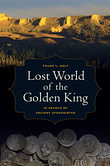 I noticed the item on Frank Holt's Afghanistan work.
From what may be a "new name" in the field, Prof. Holt is a product of the ANS Summer Seminar program from the early 1980s. Although not often published in numismatics, he has always held a fond place in his research for numismatics.
I noticed the item on Frank Holt's Afghanistan work.
From what may be a "new name" in the field, Prof. Holt is a product of the ANS Summer Seminar program from the early 1980s. Although not often published in numismatics, he has always held a fond place in his research for numismatics.
To read the earlier E-Sylum article, see: NEW BOOK: IN SEARCH OF ANCIENT AFGHANISTAN (www.coinbooks.org/esylum_v15n43a06.html)
Daniel, Schenkman and Holabird Photo
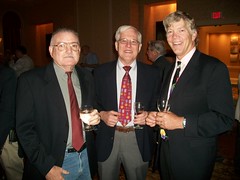 David Schenkman writes:
David Schenkman writes:
In response to the ANA banquet photograph that Howard Daniel sent in, please inform readers that Howard is the old man on the left (the young man on the right is Fred). I just don’t want to be mistaken for him.
To read the earlier E-Sylum article, see: NOTES FROM E-SYLUM READERS: OCTOBER 14, 2012: Daniel, Schenkman and Holabird at the 2012 ANA (www.coinbooks.org/esylum_v15n43a14.html)
Ganz to Review American Silver Eagles
As a follow-up to Dennis Tucker's earlier request for a reviewer for Whitman Publishing's upcoming book American Silver Eagles: A Guide to the U.S. Bullion Coin Program , Dennis received a number of responses and made this announcement on Monday:
Thank you all for volunteering to write a review of John Mercanti’s American Silver Eagles. I put everyone’s name in a proverbial hat and drew David Ganz at random to receive the advance review copy.
To read the earlier E-Sylum article, see: REVIEWER SOUGHT FOR AMERICAN SILVER EAGLES GUIDE BOOK (www.coinbooks.org/esylum_v15n42a05.html)
How to Bake Proof Coins
Harvey G. Stack writes:
A good friend and client wrote me and asked, "Is the Mint engaged now in providing baking instructions?" His wife showed him a recipe for Almond Croissants and she wondered about the instructions which were:
BUY THE FROZEN CROISSANT, JUST THAW, PROOF,(LET RISE,) AND BAKE !
She then asked, "Is this how the mint makes proof coins?"
A good Numismatic Question for all to ponder !!!!
Dave Hirt's Recent Acquisitions
Dave Hirt submitted this report on his activity in recent numismatic literature sales:
In the Kolbe-Fanning sale I was outbid on some lots I would have liked, but got a couple of lots. One was a catalog of the 1844 Devenshire sale, which you may remember sometime back I submitted as a candidate as the worst-cataloged sale.
In the Sklow sale I was also outbid, and only got one lot, but, quite interesting I think: lot 973, containing 55 works of John Muscalus on paper money.
Ithaca Hours Local Currency
Web site visitor Paul Glover writes:
I enjoyed your summary of labor currency. I'm founder of Ithaca HOURS local currency, which has transacted millions of dollars value since 1991 and author of "Hometown Money: How to Enrich Your Community with Local Currency"
For more information see:
http://www.paulglover.org/hours
and
http://www.paulglover.org/currencybook.html
To read the earlier E-Sylum article, see: EURO CRISIS REVIVES TIME BANKS AND LABOR EXCHANGE NOTES (www.coinbooks.org/esylum_v15n37a24.html)
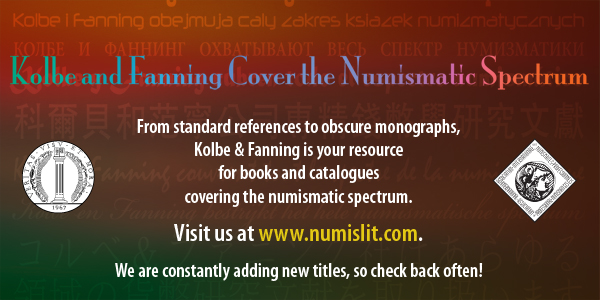
ON THE ORIGIN OF THE CONTINENTAL DOLLAR
Breen (Encyclopedia, p. 110) says that the earliest record of their existence is by Bishop Watson in 1789, cited first by Crosby, pp. 305-06. Crosby writes that they are described in Watson's Chemical Essays (Dublin, 1791, though Breen [p. 693] says the preface is dated Feb. 9, 1786). Watson thought that these were emergency coins in base metal, like the Vienna siege pieces of 1529 (though he was mistaken in thinking that the latter were made of lead).
However, in Eric Leighton's NUmiS Worthy (Old Numismatic News) 1752-1800 (a book I learned about though The E-Sylum!), an item from the Nova-Scotia Gazette & Weekly Chronicle for Jan. 4, 1780 is quoted in part. It reads:
"THE CONGRATULATION, A POEM.
Joy to great Congress, joy an hundred fold, The grand cajolers are themselves cajoled...
Whoever these important points explains, Congress will nobly pay him for his pains Of pewter dollars what both hands can hold, A thimble-full of plate, a mite of gold..."
It is difficult to read this as anything other than a reference to pewter dollars issued by the (American) Congress no later than 1779. Andrea should track down the original issue (the whole poem is 80 lines long) to see whether any other clues are present.
Also, it is possible that researchers have been looking in the wrong year for evidence of the Continental dollars. We are so used to U.S. coins being minted in the year they are dated that we forget about things like the Pine Tree shillings, dated instead to the year of authorization. Perhaps the discussion of pewter dollars took place as late as 1778 or 1779, with the date of 1776 used in honor of the Declaration of Independence.
Andrea has lots of theories about the Continental currency coins. If anyone would like to follow up with her, her email address is timbuck2two@gmail.com . -Editor
To read the earlier E-Sylum article, see: THE MYSTERIES OF THE CONTINENTAL DOLLARS (www.coinbooks.org/esylum_v15n41a21.html)
NEW RESEARCH ON THE VOTE THE LAND FREE COUNTERSTAMP
Greg Brunk writes:I have been trying to contact Robert Merchant concerning VOTE THE LAND FREE. Bob spotted the Kansas Historical site illustration of the punch shortly before me. But I've found more information about the issuer. His name was misspelled in earlier documents, but I found him by searching National Reform Association using Google "Books".


Gregory G. Brunk
The best known American political countermark is VOTE THE LAND FREE, and it illustrates the problems that are involved in identifying the issuer and reason for such pieces. Ever since a short note appeared in the 1919 Numismatist, it was assumed by coin collectors that the countermark was an Abolitionist issue of the Free Soil Party for the 1848 election.
Before the Civil War the United States had before it a problem... (regarding) the extension of slavery into the new States and Territories. The slogan "Vote the Land Free" was the campaign cry of the anti-slavery extension or Free Soil party in the election of 1848, in which General Taylor was successful, and as a campaign medallet the supporters of the party had the slogan stamped upon a number of large copper cents, some of which were holed and worn as buttonhole badges. Most of them, however, were not holed, and as they passed from hand to hand they served a two-fold purpose -- a medium of exchange and as anti-slavery extension propaganda.
Frank Duffield repeated the explanation these pieces were issued for the 1848 presidential campaign in "A Trial List of the Countermarked Modern of the World." The explanation also was accepted by John DeWitt in his 1948 Numismatist article, "Election Medals of the Campaign of 1848," and a decade later in A Century of Campaign Buttons (1959). The incorrect identification can be traced to Gustav Kobbe’s “Presidential Campaign Medals.” It appeared in Scribner’s Magazine (1888: 332-343), which is now available on the Internet. He illustrated one of these coins, which was a highly unusual thing to do in the 19th century! He also provided readers with an interesting – and totally imaginary -- story about its origin. Kobbe linked the coin to the North-South dispute over slavery, rather than the never-ending dispute in American politics between the very wealthy and the common man (1888: 348-349).
 When the Whig and Democratic conventions met in 1848, the Mexican War had been fought and the question of whether or not slavery should be prohibited in the newly acquired territory had assumed prominence; but, as heretofore, those parties dodged the issue. As a result there was a defection from both, the seceders united as the Free Soil Party and nominating Van Buren. His action in running and drawing enough votes from Cass, the regular Democratic nominee, to elect General Taylor, the Whig candidate, has of late years, and especially by those who inaugurated the Butler movement in the last campaign, been referred to as the first important “bolt” in our political history. The most interesting medal of this campaign is a battered cent, upon the obverse of which (the Liberty head) some one struck with a roughly cut die: “Vote the Land Free!” A hole punched through the coin and its battered condition prove that is was actually “worn in battle.”
When the Whig and Democratic conventions met in 1848, the Mexican War had been fought and the question of whether or not slavery should be prohibited in the newly acquired territory had assumed prominence; but, as heretofore, those parties dodged the issue. As a result there was a defection from both, the seceders united as the Free Soil Party and nominating Van Buren. His action in running and drawing enough votes from Cass, the regular Democratic nominee, to elect General Taylor, the Whig candidate, has of late years, and especially by those who inaugurated the Butler movement in the last campaign, been referred to as the first important “bolt” in our political history. The most interesting medal of this campaign is a battered cent, upon the obverse of which (the Liberty head) some one struck with a roughly cut die: “Vote the Land Free!” A hole punched through the coin and its battered condition prove that is was actually “worn in battle.”
The Free Soil Party explanation seemed reasonable, and was particularly appealing to the writer since some of my ancestors had been Free Soil Party politicians in Kansas, but the explanation was quite wrong. Bowers (2001) noted that while the Free Soil Party's slogan was "Free Soil, Free Speech, Free Labor, and Free Men," no one has discovered a Free Soil Party advertisement or political ribbon with the slogan "Vote the Land Free." He also noted that all verified coins with this stamp were minted in 1844 or earlier. (An 1846 large cent is a modern fake made from individual letter punches). This suggested the coins were used during the 1844 election or had a purpose not tied to a particular election. Robert Merchant came to the same conclusion independently of Bowers. Both of them were right, but it took years to track down the source of the countermark.
VOTE THE LAND FREE would have been an appropriate slogan for the National Reform Association, and much more reasonable for its use than by Abolitionists. The genesis of the NRA was a series of meetings in New York City in 1841 among members of the Locofocos, National Trades Union, and Workingmen’s Party. Its platform included free federal homesteads, exemption of farms from seizure for failure to pay debts, and “land limitation” to restrict the amount of land that could be owned by the wealthy, and one of the NRA’s slogans was “Vote Yourself a Farm.”
While the correct identification had been published five years before Kobbe’s article, it was in a place no numismatist would ever have thought to look. The Third Biennial Report of the Board of Directors of the Kansas State Historical Society recently appeared on the Internet. It recorded a donation by Ellis Smalley of Council Grove (1883: 62). “Iron stamp containing the monogram of the Old National Reform Party, bearing the words ‘Vote the Land Free.”

After Robert Merchant discovered the Society had the stamp in its collection, he paid them to photograph it so it could be illustrated in his 2009 article. The Society then put the photos on its website, and they jumped out at me when I searched “Vote the Land Free” using the Google “Images” option. (See Brunk 2007 for hints on how to use the Internet to identify coins, tokens and medals). I contacted Laurel Fritzsch of the Kansas Historical Society, who told me that little was known about Smalley, except he had been a “blacksmith, political activist, and former probate Judge near Council Grove, KS.”
It is the only known example of a 19th century American political countermark punch. By prorating the size of the photos on the Internet, the stamp appears to be about 4 1/2 inches long and is roughly the same diameter as a large cent. The end with the letters has been cut down slightly at its edges so the stamp would fit within the rims of a large cent. The other end of the stamp shows the effects of being hit many times with a large hammer as coins were countermarked. Both VOTE THE LAND FREE and LAND LIMITATION were countermarks of the National Reform Association, and since the NRA was organized officially in February of 1844, the coins might have been stamped in the first year of its existence. A further investigation of Smalley using Google “Books” suggests that was the case.
A warning is in order for researchers. This turned out to be a tricky. Google has digitally scanned millions of pages of books, directories, newspapers, etc., but not always correctly! At least one piece of crucial evidence regarding Smalley had been scanned incorrectly or his name was misspelled as having only one “l” in the original document. That resulted in a “typo” in the Internet text. These sorts of “typos” are common enough to be an annoyance! The way around them is to do a number of searches using different terms, such as reversing a person’s name order (last name first), trying variations of a name as people often changed the spelling of their names in the 19th century, and searching on other terms, such as “National Reform Association,” along with the last name. Finding the additional information took about two hours of Googling, and information sometimes did not appear unless one hit the proper combination of search terms.
The National Reform Association collaborated with the Fourierist movement and others to sponsor an annual National Industrial Congress. Ellis Smalley was a delegate from Plainfield, New Jersey, at the first congress held in October of 1845 and he was elected its secretary. That explains why Smalley ended-up with the VOTE THE LAND FREE stamp, and since he was a blacksmith, he might have made the stamp himself. Among his duties, on May 16, 1844, Smalley and other members of the NRA signed a letter to Joseph Smith, leader of the Mormon Church, asking Smith’s opinions concerning public lands. Smith replied from Nauvoo, Illinois, indicating he generally supported the NRA’s goals, but the first goal of a virtuous people should to abolish slavery.
By 1878 Smalley had moved to Kansas and was noted as a member of the City Council of Council Grove in a lawsuit. A few years later he was mentioned in the Congressional Record of the 46th Congress (1881) as having submitted a petition. “Ellis Smalley, of Council Grove, Kansas, that the public domain may be held and preserved exclusively for actual settlers. Referred to the Committee on the Public Lands.” (Again, this information was obtained by searching on his name using Google “Books”... Quite a useful source of information!)
References
Bowers, Q. David. 2001. Fifty Favorite Numismatic Pearls. Wolfeboro.
Brunk, Gregory G. 2007. “Internet Rules” (How to Use the Internet to Identify Numismatic Items). Numismatist 2007 Jan: 51-55, Feb: 53-55. __. “Coins Countermarked with Political Messages,” NI Bulletin continuing series since 2008, now up to Portugal.
Duffield, Frank G. 1919. “A Trial List of the Countermarked Modern Coins of the World,” Numismatist series 1919 to 1922. Reprinted in Brunk, 1976. World Countermarks on Medieval and Modern Coins. Lawrence.
Merchant, Robert J. 2009. “Vote the Land Free: A Recent Discovery Solves the Mystery,” TAMS Journal 49: 6-9.
QUERY: MINT DELIVERY WARRANTS AND TREASURER RECEIPTS SOUGHT
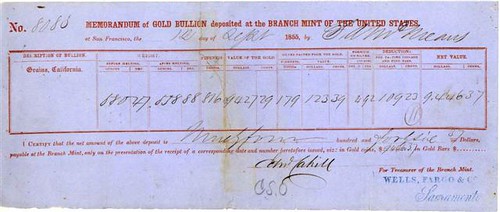
Memorandum of Gold Bullion Deposited at the Branch Mint
of the United States at San Francisco, CA 12-Sep 1855
I have recently started a project to consolidate all copper, silver and gold Delivery Warrants / Treasurer Receipts from 1793 to 1836 into an Excel spreadsheet.
Delivery Warrants were written orders from the Director of the Mint to the Chief Coiner. They specified the number of coins, by denomination, to be delivered to the Treasurer of the Mint. Treasurer Receipts were receipts written by the Treasurer of the Mint. They specified the number of coins, by denomination, that were received from the Chief Coiner.
It is my understanding that Delivery Warrant data is scattered throughout the document files at the National Archives and Records Administration, and that the spreadsheet that I am attempting to create does not exist. Presently I have the following Delivery Warrant data:
1. In Appendix I of Die Varieties of Early United States Coins, Robert Hilt II lists the Delivery Warrants for Half Dimes through Eagles. His warrant data is complete for warrants 1 through 110 (October 15, 1794 through February 28, 1798). He then lists only 8 warrants from #111 to #307.
2. Bill Eckberg provided me Treasurer Receipts of Half Cent and Large Cent deliveries from 1793 to 1811.
3. Steve Tompkins has documented Quarter Delivery Warrants though 1828 on page 396 of Early United States Quarters, 1796-1838.
4. Brad Higgins has documented the 1801 - 1807 Half Dollar Delivery Warrants in the JRJ.
If anyone has Delivery Warrant or Treasurer Receipt data that is not identified above, please contact me at dfinkelstein@comcast.net. The data that you provide will be noted in the spreadsheet. Thanks in advance for your support of this project.
To read the complete article, see: JR Newsletter: 21 October 2012 (111) (jr-newsletter.blogspot.com/)
QUERY: HOW BEST TO CATEGORIZE HORSE MEDALS?
For a few years I have been collecting and dealing in medals and tokens bearing images of the horse. I wanted to categorize these. I wonder if there might be readers having thoughts on terms proper to numismatics, other categories or any other possible refinements? The newsletter reaches those with experience and expertise that could save me reinventing the wheel, or at least the horseshoe. Here is my list thus far.
-
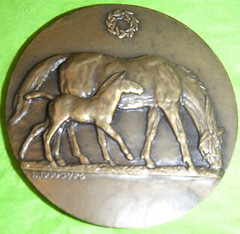 Agricultural: competitions
Agricultural: competitions
- Equestrian: breeds, show medals
- Historical/not military: events
- Military: awards, battles/campaigns, portraits, unit identification
- Portraits/not military: personal images, statuary
- Religious: St. George & etc.
- Sport: the hunt, polo, racing, rodeo
ARTICLE ON PRESSED DISK MADE FROM PLACER GOLD SOUGHT
The item on powder metallurgy was interesting and brought to mind something I have been trying to find/recall.
I remember an article in Coin World or Numismatic News Weekly about a pressed disk made from placer gold. This would be in the years ownership of bullion was prohibited. Ownership of placer gold was legal, so this was a way to “fabricate” it into a more convenient form rather than gold dust.
I have looked through CW from 1970 to 1975 (the years that I believe it would have been), but have not had the opportunity to look through NNW.
Does anyone else remember this article? I have an odd memory, and can “see it” on the right hand page (when the paper is opened) at the top. Of course, this could just be wishful thinking. Thanks very much.
To read the earlier E-Sylum article, see: NUMISMATIC VOCABULARY: POWDER METALLURGY (www.coinbooks.org/esylum_v15n43a15.html)
MEDAL LISTS, LIST MEDALS AND MEDAL PRICES
I wish to publicly thank E-Sylum reader Bruce Bartelt. He responded to my appeal in last week's E-Sylum for info on U.S. Mint's mimeographed lists offering National Medals (aka "List Medals") for sale.
"Like you," he wrote "as a teenager I requested a copy from the Mint and ordered medals in the 1960's. But I actually saved the lists!
"I would hope someone else can come up with earlier examples, but for the record I have an undated one where the last dated medal is #657 - the U.S. Secret Service 100th Anniversary, 1966. (The latest presidential medal is LBJ and the Mint's address is given as "Philadelphia 30, PA", pre-dating ZIP codes.)"
Because I had attended the dedication of the new Mint Building in 1969 -- and had purchased a copy of the Failor-Hayden published list of Mint Medals, I assumed they would have no more need for those lists. Bruce disagreed.
"And the lists didn't end in 1969 as you wrote,' he stated "for I have another 'Effective October 1, 1970".'After that the Mint produced color-printed brochures listing medals at least into the Carter presidency, of which I have several."
These lists are useful for writers and medal historians for several reasons: documenting when a certain medal was first issued and at what price.
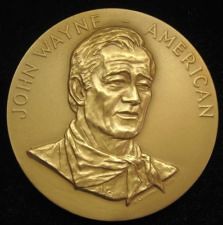 Would you believe a 3-inch medal was selling at the Philadelphia Mint for
$3.00 before 1980? A case in point. I was cataloging a collection this week that had a bronze John Wayne Congressional Medal. A college student I hire to help me asked about this medal.
Would you believe a 3-inch medal was selling at the Philadelphia Mint for
$3.00 before 1980? A case in point. I was cataloging a collection this week that had a bronze John Wayne Congressional Medal. A college student I hire to help me asked about this medal.
Yes it was the movie star, but the medal has an interesting story. Two men here in Connecticut recognized an opportunity with such an attractive medal was available at such a low price. They purchased thousands from the Mint, had them gold plated, advertised them for $10 each in Sunday supplement newspapers and sold tens of thousands to the public.
But that is not the end of the story. A graphic layout artist I employed for my auction catalogs also had worked for these same two entrepreneurs. She told me they couldn't handle the sudden windfall profits they made selling the John Wayne Medals. They split after a bitter fight over money.
You are fortunate if you have one of those John Wayne Medals in your collection -- bronze or goldplated. It was modeled by Frank Gasparro and is List #666. Oh yes, 3-inch bronze medals from the Mint are now $39.95.
PS; I'm still in need of information on earlier lists.
Last week Dick Johnson wrote, "So these mimeograph lists could have been issued intermittently from 1861 to 1968." Bob Leonard pointed out a problem with this statement. -Editor
Bob Leonard writes:
Dick cannot literally mean "mimeograph" lists as early as 1861, since the process was not invented until 1876 and typed stencils are much later than that. Early lists of medals for sale would have been printed.
In my ephemera collection I have an October 1862 U.S. mint pricelist titled "List of Medal Dies of a Public Character." I sent Dick a photocopy of it in 2003. That was before we started using images in The E-Sylum, so I made a scan tonight. Readers can view the images below. Click on it to see a larger version on our Flickr archive. Does anyone have an earlier one? -Editor
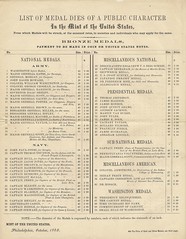
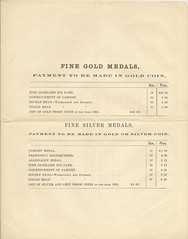
To read the earlier E-Sylum article, see: RESEARCHER SEEKS FIRST LIST OF MEDALS FOR SALE BY U.S. MINT (www.coinbooks.org/esylum_v15n43a16.html)
SHOULD THE U.S COMMEMORATIVE COIN PROGRAM BE SHUT DOWN?
Chris Fuccione writes:I saw that the President just signed into law a bill the Lions Club International Century of Service Commemorative Coin Act. Once again it looks like the government is abusing the commemorative coin program and issuing coins that do not have a wide appeal. Before the program crashes again like it did in the 30's and the 80's can we try and get them to issue a The Numismatic Bibliomania Society Commemorative Coin??? Just wondering?!? LOL!!!
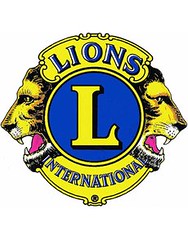
To read the complete Coin World article, see: Obama OKs Lions Club commemorative coin (www.coinworld.com/articles/obama-oks-lions-club-commemorative-coin/)
The first U.S commemorative coin program was shut down in 1954 and the door to further issuance was nailed shut for 28 years because of abuses in the authorization and sales processes in the 1920s and 1930s.
Are we at such a point today when shutting the program down becomes the only logical remedy?
Reading the Page 1 story by David Ganz certainly makes me think so.
It is hard for me to write those words in one sense because back in 1982 when the modern commemorative program began, I was one of those commemorative coin starved collectors who had no memory of either those coins or the abuses that caused their termination.
I can’t speak for future generations of potentially commemorative starved collectors who will hanker to see their return if we do in fact abolish them, but that’s just the point. Future collectors in the generation to follow us will be able to make their own judgments just as we did back in 1982.
The hobby market will be able to work its own healing on the current oversupply of many of the commemoratives that were struck since 1982. I imagine the melting pot will capture many of them if gold and silver continue current trends and that could improve the desirability of the survivors.
To read the complete article, see: Time to kill off commemoratives (www.numismaticnews.net/article/time-to-kill-off-commemoratives)
1962 SEATTLE WORLD'S FAIR DOLLAR DISPLAY BROCHURE
Regarding the million-coin display of silver dollars at the 1962 Seattle World's Fair, Web site visitor Bob Buch writes:
Google lead me to your article about the silver dollar display (here). Walt Behlen was a first cousin of my mother, so our parents took us to see the exhibit. I have one of the original tri-fold brochures from the display, and have attached a PDF that I file made from it. It has some additional details you might find useful if the subject comes up again
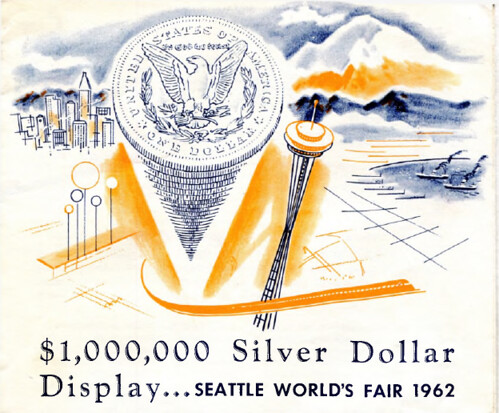
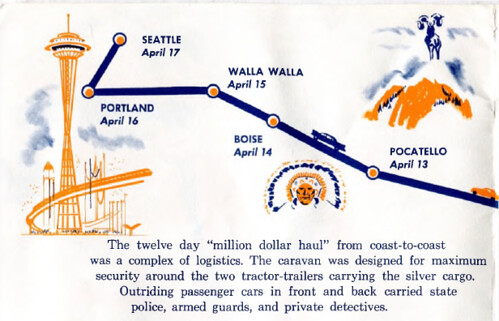
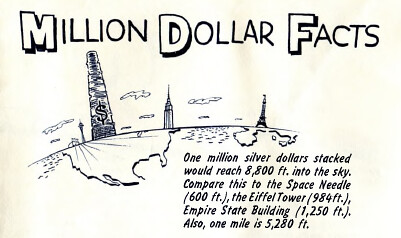
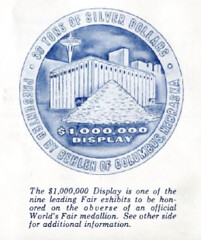
To read the earlier E-Sylum articles, see:
1962 SEATTLE WORLD'S FAIR MILLION SILVER DOLLAR EXHIBIT
(www.coinbooks.org/esylum_v10n49a14.html)
and
MORE ON THE 1962 SEATTLE WORLD'S FAIR MILLION SILVER DOLLAR EXHIBIT
(www.coinbooks.org/esylum_v13n50a19.html)
HARVEY STACK : HOW NEW YORK BECAME THE “COIN CAPITAL OF THE WORLD”
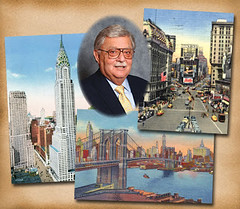 When considering the growth of numismatics in America, it can be found that coin collecting as a hobby, started to grow in size in the northeast states, from Maine to Virginia, after the Civil War. Some great collections were developed by the famous Adams family, the Garrett family, and other great collectors. Though they each had a profound interest in colonial and early American coins, their proximity to the Mint in Philadelphia gave them a great source for developing their collections.
When considering the growth of numismatics in America, it can be found that coin collecting as a hobby, started to grow in size in the northeast states, from Maine to Virginia, after the Civil War. Some great collections were developed by the famous Adams family, the Garrett family, and other great collectors. Though they each had a profound interest in colonial and early American coins, their proximity to the Mint in Philadelphia gave them a great source for developing their collections.
There seemed to be a concentration of dealers in the New York area. After all, the city was known for its jewelry trade and it was easy for dealers to move into coins (which were also precious metal) than some other field.
Around the country, some dealers were already in the field. Wayte Raymond, F.C.C. Boyd, McAllistar, John Zug, Tom Elder, Barney Bluestone, Henry Chapman, and David Proskey to mention a few, together with the great promoter and super-advertiser of the time, B. Max Mehl of Fort Worth, Texas.
Many of the dealers of the period lived and worked in New York and it was easy to see how these dealerships grew. New York offered a group of numismatic organizations including the most important, the American Numismatic Society. Also to be found were the New York Numismatic Club, the Bronx and Brooklyn numismatic clubs, and the Chase Money Museum, plus a number of other museums that included coins as part of their displays. All this attracted collectors to the city and it became a “hub” for numismatics.
Many of the auctioneers who sold collections for clients chose New York as the place to sell. It was located in an area where many collectors lived and was easily reached from Boston, Hartford, the five New York boroughs, affluent Westchester County, Connecticut, New Jersey, Philadelphia, Washington DC, Baltimore, and all the other main collecting cities. During the Stack family’s tenure in the city they held over 800 public auctions there and attracted thousands of collectors.
Even now out of town dealerships want to establish themselves in New York, the natural center of numismatics. In recent years the well-known firm of Heritage Numismatics opened a shop just a few blocks away from the Stack’s “clubhouse.” They are not the first Texans to test their business in New York. In the 1930s B. Max Mehl came to New York to partner with Wayte Raymond, but found that the “Big City” was not for him and returned to Fort Worth, where he conducted mail bid auctions and, sadly, never returned to New York.
And now you know why New York is the “Coin Capital of the World”!
To read the complete article, see: Remember When: How New York Became The “Coin Capital Of The World” (stacksbowers.com/Blogs/remember-when-how-new-york-became-coin.html)
COIN COLLECTING AND DEALING IN DALLAS, TEXAS
Dallas doesn’t have the long numismatic history that New York, Boston and Philadelphia have but despite the fact that it is a comparatively new city, I’d venture to say that it is the epicenter of the modern coin market. The two most important coin dealers of all-time were located in Dallas and at least three to five of the greatest collections of American coins ever formed were created in Dallas as well.
Mehl built his business around clever promotions, self-promotion and using direct mail and advertising at a time when no other coin dealers were doing this, let alone doing this successfully. It is said that his advertising budget in the 1930′s and 1940′s approached $1 million per year and that at one time a significant portion of the daily mail that arrived in the city of Ft. Worth was addressed to Mehl.
Heritage Rare Coins, located in Dallas, is to the 21st century coin market as Mehl was to the market in the first half of the 20th century. The internet has surely been one of the major factors in the changing of numismatics in the last decade and no one has capitalized on the new web-based technologies more than Heritage.
At this point, the rare coin market is as close to a monopoly as it has ever been and I attribute this to Heritage making many very smart decisions in the last fifteen years and their competition conveniently making many dumb decisions. Heritage now completely dominates the American numismatic auction business and they have essentially eliminated their competition save for Stack’s Bowers. It is hard to remember that as recently as a decade ago there were at least five thriving competitors in the coin auction business.
The brilliance of Heritage’s marketing strategy was to realize before anyone else the impact that the internet would have on the coin market and how being transparent would create a more comfortable bidding and buying environment for collectors. So many of the things that we as a hobby take for granted now (safe online bidding, a database of coin prices and populations, high quality digital images, etc) were either pioneered or perfected by Heritage.
The first great local coin collection in the Metroplex was formed by Amon Carter Sr and his son Amon Carter Jr. The bulk of this collection was sold at public auction by Stack’s in January 1984. I didn’t attend this sale but the story behind it, as I recall, was that the weather in New York was awful and that it was not as well-attended with out-of-town buyers as it should have been due to this. The Carter sale was one of the really great auctions of the era even though it is not as well-remembered as Norweb, Garrett, etc.
The next great Dallas collection is a name better-known to gold coin collectors: Harry W. Bass. The Bass collection, which was mostly sold in a series of four auctions conducted by Bowers and Merena between 1999 and 2001, contained the most comprehensive date and variety set of Liberty Head gold coins ever assembled.
I attended the Bass II, Bass III and Bass IV sales in New York in 1999 and 2000 and, even then, I think I was sufficiently aware of their significance. In some ways, these sales were the defining moment of the end of the old-school coin market; the point in time just before the internet took , when dealers still attended sales in person and when a gigantic event like Bass II (over 2,000 lots and with thousands and thousands of interesting individual and grouped coins) could be “carved up” by groups of dealers and dominated by six to eight buyers.
There are two currently active collections in Dallas/Ft. Worth that deserve mention and they are clearly among the five greatest American sets ever formed. The first is the Pogue family. This set is not all that well-known outside of the “inner circle” of dealers and collectors but it is incredible. The scope of the collection is Gem quality U.S. coins struck from the 1790′s until around 1900 with an emphasis on Gem early silver and gold.
I have never had the good fortune to view this collection in its entirety but I have had the chance to view it in dribs and drabs. The Pogues got really serious about coins during the Eliasberg sale in October 1982 and they bought heavily out of what was arguably the greatest collection of U.S. gold ever formed. They continued to buy aggressively in the 1980′s and 1990′s with the guidance of David Akers, Larry Hanks and others. I have had to compete against the Pogues at a number of auctions and when they want a really great coin, needless to say that are formidable competitors. From what I know about this collection, it is the single greatest set of its type ever assembled and it is certainly the one set that I would pay to be able to view it.
The other great collection in located in Ft. Worth and it belongs to Bob Simpson, the current owner of the Texas Rangers baseball team and the former CEO of XTO Energy. Simpson is much newer to the market than the Pogues but he has assembled an amazing, comprehensive collection in less than a decade. To his credit, he has done this in a highly competitive environment in which information is more accessible than ever, few coins sell under the radar.
To read the complete article, see:
Dallas Texas and the History of American Coin Collecting
(raregoldcoins.com/market-blog/dallas-texas-and-the-history-of
-american-coin-collecting)
NEWS PUBLICATIONS CONTINUE SHIFT FROM PRINT TO ONLINE
Newsweek will end its print publication after 80 years and shift to an all-digital format in early 2013.
Its last U.S. print edition will be its Dec. 31 issue. The paper version of Newsweek is the latest casualty of a changing world where readers get more of their information from websites, tablets and smartphones. It’s also an environment in which advertisers are looking for less expensive alternatives online.
The announcement of the change was made Thursday by Tina Brown, editor-in-chief and founder of The Newsweek Daily Beast Co, and Baba Shetty, its CEO. Job cuts are expected.
“In our judgment, we have reached a tipping point at which we can most efficiently and effectively reach our readers in all-digital format,” Brown and Shetty said on The Daily Beast website.
Newsweek isn’t the first to drop its print product. US News & World Report dropped its weekly print edition years ago and now focuses on the Web and special print editions, such as a guide to best graduate schools. SmartMoney announced in June that it was going all-digital.
Newsweek’s print edition has been losing relevancy over the years as readers flocked to new, digital sources for news.
To read the complete article, see:
Newsweek ending its print publication after 80 years, will shift to all-digital format
(www.washingtonpost.com/business/newsweek-ending-its-print-publication-will
-shift-to-online-format-job-cuts-expected/2012/10/18/
1ffd2c6e-1919-11e2-ad4a-e5a958b60a1e_story.html)
THE BOOK BAZARRE
OBSOLETE BANKNOTE EXHIBIT: CAPITAL OF CAPITAL: NEW YORK’S BANKS
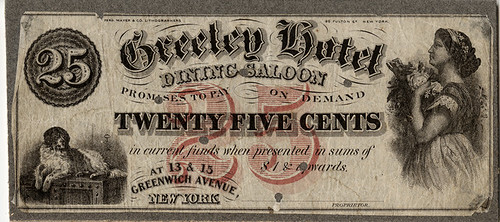
Before the institution of federally backed paper currency in 1862, the government didn’t see issuing paper money as its responsibility. Although it coined gold and silver, there was never enough in circulation to provide an effective medium of exchange. Because the Constitution prohibited states from printing money, banks became the primary suppliers of paper money in the U.S.
From 1791 to 1811, and then again from 1817 to 1836, the First Bank of the United States and the Second Bank of the United States brought a degree of order to this system, both regulating the issue of bank notes and issuing their own trusted notes. But when Andrew Jackson failed to renew the second bank’s charter in 1836, private bank notes proliferated unchecked. By the 1850s, U.S. banks had issued more than 10,000 kinds of bank notes, varying in size, denomination, design and value. (Many of them are now on display at the Museum of the City of New York.)
When banks couldn’t provide an adequate supply of money, other institutions stepped in. In particular, there was demand for small-denomination bank notes and coins. (In 1840, per- capita annual income in the U.S. was about $65, so a $1 bank note was a lot of money.) Hotels, restaurants and bars that didn’t have enough coins and bank notes to make change issued their own money in small denominations. A note issued by one hotel promised “to pay on demand twenty five cents in current funds when presented in sums of $1 & upwards.”
A note worth 25 cents in the hotel lobby would have changed hands at a steep discount just a few blocks away. Meanwhile, small towns issued bank notes of a few cents to support local commerce. In Virginia, people were reduced to cutting apart large bank notes and circulating them in pieces.
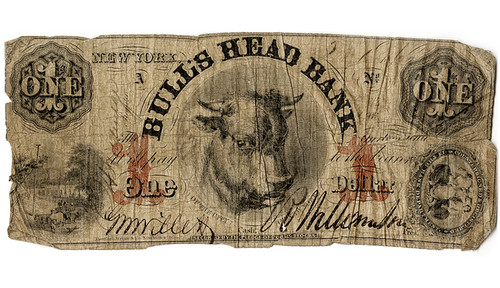
In this unpredictable environment, spending a dollar required some serious thinking. A wallet might have three, five or a dozen different bank notes -- a bull’s head staring back at you from a Bull’s Head Bank note, or a Marine Bank bill illustrated with ships -- not to mention foreign coins from around the world and personal checks, which also circulated as money. Most bank notes traded at a discount based on the reputation of the bank and how far the note was from where it originated.
To read the complete article, see:
When Banks Were Able to Print Their Own Money, Literally
(www.bloomberg.com/news/2012-10-19/when-banks-were-able-to
-print-their-own-money-literally.html)
ROMAN GOLD COIN HOARD FOUND IN HERTFORDSHIRE
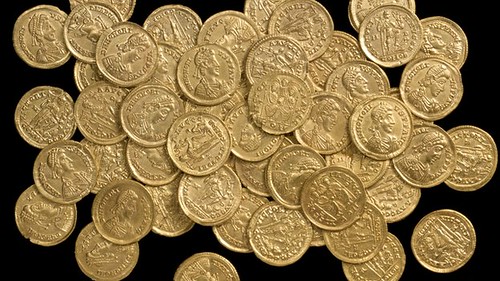
A "nationally significant" hoard of Roman gold coins has been found by a metal detectorist in Hertfordshire.
The stash - found on private land north of St Albans - is believed to be one of the largest Roman gold coin hoards discovered in the UK.
The 159 coins date to the end of the 4th Century during the final years of Roman rule in Britain. After AD 408 no more coin supplies reached the country.
The council said the coins were scattered across a fairly wide area and that there were "practically no other comparable gold hoards of this period".
They were mostly struck in the Italian cities of Milan and Ravenna and issued under the Emperors Gratian, Valentinian, Theodosius, Arcadius and Honorius.
Councillor Mike Wakely called it "an exciting find of national significance" and said the coins would go on display at Verulamium Museum.
David Thorold, from the museum, said that during Roman occupation, coins were usually buried either as a religious sacrifice to the Gods, or as a secure store of wealth to recover later.
To read the complete article, see: Roman gold coin hoard found in St Albans is 'nationally significant' (www.bbc.co.uk/news/uk-england-beds-bucks-herts-19965507)
Philip Mernick writes:
The British Museum hadn’t seen the coins when I asked a couple of days ago and the St Albans Museum haven’t answered my enquiry. All the coins pictured seem to be of Honorius although the text mentions Gratian, Valentinian, Theodosius, Arcadius in addition to Honorius
For a related article sent by David Sundman, see: Roman coin hoard discovered in St Albans (www.hertsad.co.uk/news/roman_coin_hoard_discovered_in_st_albans_1_1659995)
QATARI SHEIK LATE IN PAYING FOR COIN PURCHASES
Noble Investments, a rare coin and stamp dealer, is chasing a Qatari coin collector for £2.2m after he failed to pay for his auction purchases. The commission is due to Baldwin’s, Noble’s main subsidiary, and amounts to a fifth of the group’s estimated revenues for 2012.
Ian Goldbart, managing director, is confident that the money will be paid: “The collector has never denied buying at the auction. It’s not a question of if we get paid, but when.” Shares in the Aim-quoted group fell 2.8 per cent to 185.5p, following the announcement. Noble declined to reveal the identity of the Qatari, although the group said in a statement that he was a “significant” collector.
The coin and stamp dealer will retain the coins and will consider another auction if they do not receive their payment. Mr Goldbart reiterated that non-payment remained unlikely. “I doubt this will happen – I really can’t see this not being paid for,” said Mr Goldbart. The company is, however, receiving legal advice.
Non-payment is an occasional hazard for coin and stamp dealers, according to Mr Goldbart, especially with larger collectors. “It doesn’t happen very often with us. When you have major collectors, it’s difficult to ask for a deposit before an auction. Auctions are on trust – you have to trust bidders to honour their commitment, whether you’re Sotheby’s or us.”
The non-payment blots an otherwise strong year for the company, with the market for extremely rare coins proving resilient throughout the financial crisis. Baldwin’s broke the world record for the most expensive English or Australian coin, after it sold a George V 1920 Sydney mint sovereign for £780,000 in September.
This sale came on the back of a similarly successful auction of 642 ancient Greek coins in January, which fetched a record $25m. The boost from the Greek sale helped Noble report a 59 per cent jump year-on-year in pre-tax profits to £2.4m for the first half of their financial year.
To read the complete article, see: Noble chases Qatari coin collector for £2m (www.ft.com/intl/cms/s/0/632b8764-1799-11e2-8ebe-00144feabdc0.html#axzz29VmkiCtB)
 Nowadays it has become an usual scenario. The lion's share of the top auctions of ancient material - whether tetradrachms or fractions - goes to the bidder from Qatar. According to a preliminary addition of Hadrien Rambach, a London-based coin-advisor, who was attending the sale, the sheik bought 41 lots for over 1 million pounds (more than $1.5 million) during the recent auction of Morton & Eden.
Nowadays it has become an usual scenario. The lion's share of the top auctions of ancient material - whether tetradrachms or fractions - goes to the bidder from Qatar. According to a preliminary addition of Hadrien Rambach, a London-based coin-advisor, who was attending the sale, the sheik bought 41 lots for over 1 million pounds (more than $1.5 million) during the recent auction of Morton & Eden.
To read the earlier E-Sylum article, see: QATARI SHEIK ON COIN-BUYING SPREE (www.coinbooks.org/esylum_v14n45a16.html)
BONHAMS SELLS RARE QATAR AND DUBAI BANKNOTES
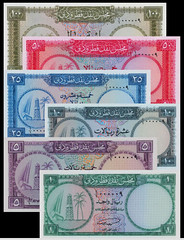 A series of rare Qatar and Dubai banknotes sold for £180,000 against a £25,000-35,000 pre-sale estimate at Bonhams auction of Banknotes and Coins in Knightsbridge, London, today.
A series of rare Qatar and Dubai banknotes sold for £180,000 against a £25,000-35,000 pre-sale estimate at Bonhams auction of Banknotes and Coins in Knightsbridge, London, today.
These uncirculated notes are extremely rare. The matching early serial numbers further enhanced this rare set. The sale included many rare coins from a variety of countries and periods from as far back as Egypt 285 BC the rule of the Ptolemaic kings. The sale raised a total of £580,194 with 90 per cent of the lots sold.
John Millensted, Head of Coins at Bonhams, commented after the sale: “It is a tremendously rare set and has been preserved well over the years, the price exceeded all expectations and we are very pleased with the result.”
The notes issued by the Qatar & Dubai, Currency Board, were a full set of 1, 5, 10, 25, 50 and 100 Riyals from September 1966, all serial number 000009.They were held in a blue leather presentation album with the inscription on the cover that read: 'Council For the Currency of Qatar & Dubai'. The notes all have a vignette containing a dhow, derrick and palm tree at left, reverses with denomination at centre and upper corners, and issuing authority across the top. The notes were lightly mounted on card pages and held in place by thin strip of masking tape on back of right edge.
The Qatar-Dubai Currency Agreement was signed in March 1966 in preparation for the establishment of a Currency Board and the subsequent introduction of a common currency. In September of that year the Currency Board issued its first paper money but within less than seven years the Currency Agreement had been terminated.
Qatar proceeded to issue its own paper currency while the new issue from United Arab Emirates Currency Board entered circulation in Dubai.
With the exception of the 1 riyal, notes of the Qatar & Dubai Currency Board are very difficult to find in high grade and the 25 riyal had such a low issue that it is difficult to find in any condition.
To read the complete article, see: Rare Qatar and Dubai banknotes sell way above estimate at Bonhams in London (www.artdaily.org/index.asp?int_sec=2&int_new=58378#.UICticXA8dc)
IRAN SANCTIONS MAY CUT BANKNOTE SUPPLIES
Western economic sanctions imposed on Iran over its disputed nuclear program have severely depressed the value of its national currency, the rial, causing higher inflation and forcing Iranians to carry ever-fatter wads of bank notes to buy everyday items. But the sanctions have also presented a new complication to Iran’s banking authorities: they may not be able to print enough money.
At least three European companies that have been providing currency production services to Iran say they have stopped doing business there. One of the companies, Koenig & Bauer AG of Würzburg, Germany, also says it has not responded to an Iranian request for bids to make presses to print new rials.
Koenig & Bauer’s disclosure was contained in a mailed response to a query by United Against Nuclear Iran, a New York-based sanctions advocacy group, which seized upon the 40 percent drop in the rial’s value this month to begin a campaign aimed at the currency itself.
The group began by pressing the Europe-based bank note industry, which has historically counted Iran as a client, to further ostracize the country by denying its central bank the basics of a functioning currency system: the printing presses, engraving paper, anticounterfeiting technology and other services needed to provide enough rials.
To read the complete article, see:
Iran Sanctions May Cut Supply of Currency
(www.nytimes.com/2012/10/17/world/middleeast/irans-supply
-of-currency-may-be-at-risk-in-sanctions.html)
FIVE HILARIOUSLY BAD YOUTUBE COIN VIDEOS
YouTube, that veritable cornucopia of pirated television shows, videos for every album track ever, and annoying oranges, continues to surprise us with the sheer depth of topics with which someone with a few too many free moments on his or her hands can indulge the rest of us. From coin reviews by guys who don’t know the slightest thing about the coins they’re reviewing, to a little tongue-in-cheek dealer inside baseball, to an epic fail bullion experiment at a McDonald’s drive-thru, and even the most awesome coin roll hunt of all time, the following five must-see clips will change the way you look at coins… forever!
To read the complete article, see: Five Hilariously Bad YouTube Coin Videos (www.coinweek.com/commentary/five-hilariously-bad-youtube-coin-videos/)
JED CLAMPETT'S TRAVELLING NUMISMATIC BOOKMOBILE
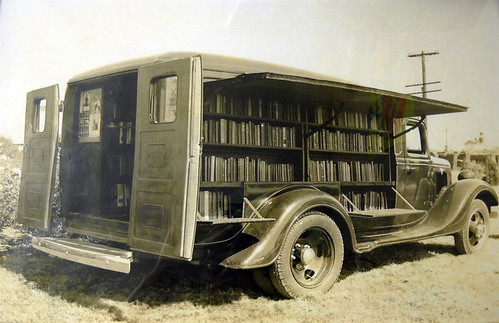
To read the complete article, see: Time-Traveling Librarians from Outer Spa... from Texas (boingboing.net/2012/10/19/time-traveling-librarians-from.html)
FEATURED WEB SITE: FLEUR DE COIN
This week's Featured Web Site is Fleur de Coin, suggested by Dick Johnson.Named after the highest coin grade, this website is the result of the love and hard work of just one person... myself! Endless hours of coding, recoding, designing, adding content and revising content have been put into this site since 1998, when it's first incarnation appeared on-line drawing only a miniscule web traffic. A lot of things have changed during the past few years, making Fleur-de-Coin a rather interesting and informative website that attracts over 12,000 visitors each month. The site has grown but although it looks like the result of the combined work of a professional web developer and an avid coin collector, the fact remains that it is only a personal contribution to the coin collector community worldwide.
If you are wondering where to begin. If you have found coin collecting too bewildering and don't know where to start. If you are just too busy to track down the information you need to get started, here is a free place with heap of information which is aimed right at people like you. Fleur-de-Coin.com is geared mainly towards collectors searching for information about the Greek modern coins and the european currency. Although this is the main focus of the site, I have tried my best to include interesting content about coin collecting in general, ranging from little-known facts to complete series of articles about coin minting and more. Each coin included in this site (Greek drachmas, lepta, euros and cents) is well presented with high-resolution photos, specifications and a brief description of the theme it portrays.

www.fleur-de-coin.com
